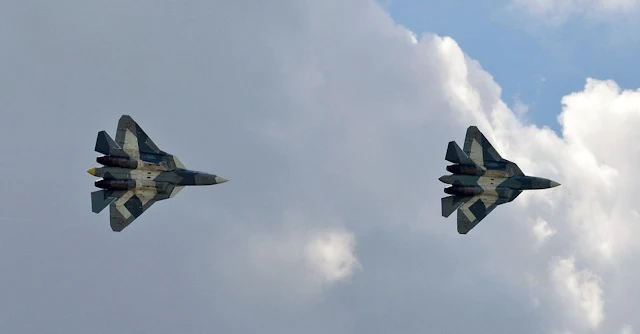 |
| Russian Sukhoi Su-57 fighter jet. (Wikimedia Commons/Anna Zvereva) |
International Military - The Su-57 Felon fighter jet is said to have plunged into the conflict between Russia and Ukraine. This has also been directly claimed by Russian state media in a report.
According to anonymous insiders interviewed by state news agency TASS, the plane was suspected of being involved in the war for most of its duration. "The use of the Su-57 aircraft in Ukraine began two-three weeks after the start of Special Operations [how Russia described its invasion of Ukraine.
The aircraft operates outside the enemy's air defense activity zone. They [the planes] used missiles," said a TASS source. Reporting from aerotime.aero, TASS said the claims had not been independently verified. But there was no official statement from the military or Russian authorities on the matter.
The Sukhoi Su-57 is Russia's first fighter jet with stealth characteristics and the only fifth-generation fighter jet. Intended to rival America's Lockheed Martin F-22 Raptor and China's Chengdu J-20, it made its maiden flight in 2010.
According to the defense ministry, three series-produced Su-57s were in service with the Russian Air Force as of May 2022, in addition to several prototypes whose status is unclear. The first serial production Su-57 crashed during testing in 2019 before being delivered to the armed forces. There have been many reports of the Su-57 being used in Ukraine, mostly based on alleged witness sightings and unverified footage.
So far, most of the footage purported to show the Su-57 in action has not been verified and sightings of the Su-57 cannot be substantiated to show the Su-57 specifically. In addition, the use of the Su-57 is also one of Russia's major considerations. The reason is, the Su-57 is the newest Russian jet. This means the Su-57 is not yet in Russian service.
For this reason, currently what can be confirmed are the Su-35 to Su-34, which are thought to have entered the conflict.
However, the capabilities of the Su-57 are far superior. Moreover, the testing of the new fighter in the war zone, as was previously done with various airframe prototypes in Syria, has made the war in Ukraine a valuable opportunity to advance the program.
Reporting from Military Watch Magazine, the Su-57 has the most capable electronic warfare capabilities. The aircraft has six electronically scanned array radars throughout the fuselage. The fuselage operates in different bands which are very well optimized to disrupt enemy communications and blind air defenses.
The aircraft is also equipped with a laser defense system intended to blind infrared-guided weapons. The Su-57 also integrates the 'Himalayan' electronic warfare system. This system is not stored in one area of the fuselage but is distributed throughout the fuselage including the wings to further interfere with enemy targeting systems.
The fighter aircraft can thus be deployed in the electronic attack role to suppress enemy air defenses. It also makes it limit situational awareness and provides a power multiplier for other units. This can be achieved with just one Su-57 accompanying an older aircraft, and potentially allows even a small number of aircraft to have an impact on the battlefield.
Quoted from Airforce Technology, the Su-57 is the result of the Russian Air Force's PAK FA fifth generation fighter jet program. Codenamed 'Felon' by NATO, the Su-57 is a twin-engine stealth fighter to be used in anti-air and air-to-ground operations.
Developed by the Sukhoi Design Bureau and the Russian Aircraft Corporation, the aircraft made its maiden flight in August 2019. Russia's first stealth fighter jet will provide the country's armed forces with advanced capabilities in terms of stealth, speed, weapons and sensors.

fly low and see what happens.
ReplyDelete